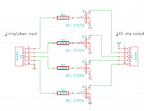fenixxxxx
Newbie level 2
Hi guys,
recently I got an Philips LivingColors lamp. I wasn’t too happy with its brightness so I decided to do small hardware modification. I added few N-channel transistors to the LED drivers and connected an RGB LED strip. The effect was really impressive. The single lamp with a strip was able to light up the complete room. The control of the lamp is done via a standard remote control.

Here is how to connect the LED strip to the lamp:
- The lamp includes four high power LEDs with PWM drives. Adding the additional load to the drivers can result in circuit damage. That is why to drive safely the external LEDs we need four N-channel Mosfet transistors to increase driver current capacity. Additionally the transistors allow to connect voltage drivers directly to 12V LEDs strip. Assembly the transistor amplifier circuit according to the following schematic on the breadboard:

- Disassemble the lamp by removing the front plate to get the access to the PCB. Locate the suitable points for soldering the wires from the lamp LED drivers to the transistor board circuit.
- Connect the board output connector to the RGB LED strip
Here is the YouTube movie with final result:
Here is step by step instructions how to modify Philips LivingColors lamp with schematic:
Phlips LivingColors lamp brightness increase with a LED strip
recently I got an Philips LivingColors lamp. I wasn’t too happy with its brightness so I decided to do small hardware modification. I added few N-channel transistors to the LED drivers and connected an RGB LED strip. The effect was really impressive. The single lamp with a strip was able to light up the complete room. The control of the lamp is done via a standard remote control.

Here is how to connect the LED strip to the lamp:
- The lamp includes four high power LEDs with PWM drives. Adding the additional load to the drivers can result in circuit damage. That is why to drive safely the external LEDs we need four N-channel Mosfet transistors to increase driver current capacity. Additionally the transistors allow to connect voltage drivers directly to 12V LEDs strip. Assembly the transistor amplifier circuit according to the following schematic on the breadboard:

- Disassemble the lamp by removing the front plate to get the access to the PCB. Locate the suitable points for soldering the wires from the lamp LED drivers to the transistor board circuit.
- Connect the board output connector to the RGB LED strip
Here is the YouTube movie with final result:
Here is step by step instructions how to modify Philips LivingColors lamp with schematic:
Phlips LivingColors lamp brightness increase with a LED strip